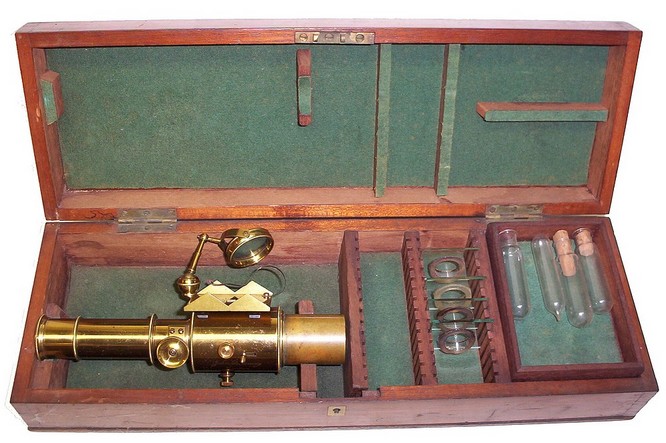



The follolwing extracted from: Spectrum analysis in its application to terrestrial substances by Heinrich Schellen, 1872
The Sorby-Browning Microspectroscope.

The object of this instrument is to facilitate the accurate observation of the absorptive phenomena of the smallest solid and liquid bodies, such as are prepared for microscopic examination a corpuscule of blood, for instance.* Sorby, with the assistance of Browning, has so arranged the spectroscopic part of the instrument that it can be applied to any microscope by fixing it in the place of the ordinary eye-piece so that the spectroscopic investigation of an object can be pursued without any change in the manner of using the instrument. In a complete instrument a contrivance is attached to the side by means of which the substances to be investigated may be compared with the spectra of known substances: this apparatus consists of a small stage, a prism for comparison (38), and a movable scale for measuring accurately the places of the absorption bands.
Fig. 73 shows a perspective view of the whole instrument, as fitted to slide into the upper tube of the microscope in place of the eye-piece; Fig. 74 gives a section showing the internal construction ; and Fig. 75 gives a section through the plane of the two screws C and H, exhibiting the slit with its contrivances for adjustment and the prism for comparison.
The tube A encloses a second tube carrying a direct-vision system of five prisms c, and an achromatic lens l (Fig. 74); by means of a milled head B, with screw-motion, this inner tube can be moved up and down, so that the slit situated in the plane of the screws C and H may be in the focus of the lens I; consequently the rays from the slit, after passing through the lens, fall parallel on to the prisms.

Fig. 74; Section of the Microspectroscope.
D D is the stage on which the objects for comparison liquids between plates of glass or in small tubes are secured within notched edges, by means of metal springs, which hold the small glasses in such a position that the light falling on them from the side, after its passage through the liquid, reaches a square opening in the middle of the stage, whence, as Fig. 74 shows, it passes through a side opening o into the inside of the principal tube, and falls upon the reflecting prism R, which acts as a prism for comparison. When the apparatus for comparison is not required, the square opening in the stage D D is closed by a sliding plate by means of the screw E, so that the side-light may be shut out of the instrument.
